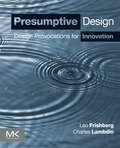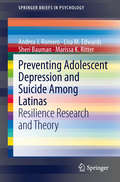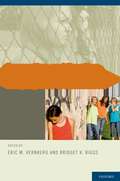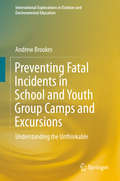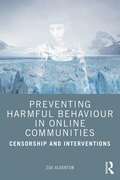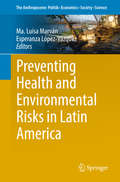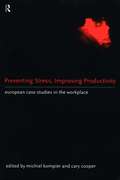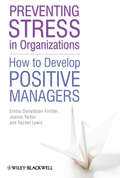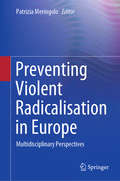- Table View
- List View
Prestige Television and Prison in the Age of Mass Incarceration: A Wall Rise Up (The Cultural Politics of Media and Popular Culture)
by Victoria M. BryanTelevision shows that we might call ‘prestige television’ represent prison in ways that are sometimes reductive, sometimes powerful, and sometimes exceedingly complex. This book examines various programmes across the genres of drama, comedy and horror that utilize prison or places of incarceration as a central theme or setting to show how they conform to or challenge the standard conversation about the prison industrial complex and the common understanding of prisons as violent spaces where we house the worst among us. Drawing on the work of Angela Davis, Doran Larson, Dylan Rodriguez, Michelle Alexander, and Lisa Guenther, the author presents focused studies of Orange Is the New Black, Rectify, American Horror Story and The Walking Dead (along with briefer discussions of The 100, police procedurals, and popular sitcoms) to explore the responsibility of television to represent prison in as authentic a fashion as possible, the exploitation of the incarcerated in reductive representations of prison, and the shifting nature of the national conversation about prison as it is depicted on screen. As such, the book will appeal to scholars of cultural and media studies, criminology and sociology with interests in incarceration and representations of prison in popular culture.
Prestige Television and Prison in the Age of Mass Incarceration: A Wall Rise Up (The Cultural Politics of Media and Popular Culture)
by Victoria M. BryanTelevision shows that we might call ‘prestige television’ represent prison in ways that are sometimes reductive, sometimes powerful, and sometimes exceedingly complex. This book examines various programmes across the genres of drama, comedy and horror that utilize prison or places of incarceration as a central theme or setting to show how they conform to or challenge the standard conversation about the prison industrial complex and the common understanding of prisons as violent spaces where we house the worst among us. Drawing on the work of Angela Davis, Doran Larson, Dylan Rodriguez, Michelle Alexander, and Lisa Guenther, the author presents focused studies of Orange Is the New Black, Rectify, American Horror Story and The Walking Dead (along with briefer discussions of The 100, police procedurals, and popular sitcoms) to explore the responsibility of television to represent prison in as authentic a fashion as possible, the exploitation of the incarcerated in reductive representations of prison, and the shifting nature of the national conversation about prison as it is depicted on screen. As such, the book will appeal to scholars of cultural and media studies, criminology and sociology with interests in incarceration and representations of prison in popular culture.
Presumptive Design: Design Provocations for Innovation
by Leo Frishberg Charles LambdinEverything you know about the future is wrong. Presumptive Design: Design Provocations for Innovation is for people “inventing" the future: future products, services, companies, strategies and policies. It introduces a design-research method that shortens time to insights from months to days. Presumptive Design is a fundamentally agile approach to identifying your audiences’ key needs. Offering rapidly crafted artifacts, your teams collaborate with your customers to identify preferred and profitable elements of your desired outcome. Presumptive Design focuses on your users’ problem space, informing your business strategy, your project’s early stage definition, and your innovation pipeline. Comprising discussions of design theory with case studies and how-to’s, the book offers business leadership, management and innovators the benefits of design thinking and user experience in the context of early stage problem definition. Presumptive Design is an advanced technique and quick to use: within days of reading this book, your research and design teams can apply the approach to capture a risk-reduced view of your future.Provides actionable approaches to inform strategy and problem definition through design thinkingOffers a design-based research method to complement existing market, ethnographic and customer research methodsDemonstrates a powerful technique for identifying disruptive innovation early in the innovation pipeline by putting customers firstPresents each concept with case studies and exploration of risk factors involved including warnings for situations in which the technique can be misapplied
Pretend the World Is Funny and Forever: A Psychological Analysis of Comedians, Clowns, and Actors
by S. Fisher R. L. FisherFirst published in 1982. Routledge is an imprint of Taylor & Francis, an informa company.
Pretend the World Is Funny and Forever: A Psychological Analysis of Comedians, Clowns, and Actors
by S. Fisher R. L. FisherFirst published in 1982. Routledge is an imprint of Taylor & Francis, an informa company.
Preterm Birth in the United States: A Sociocultural Approach
by Janet M. BronsteinThis first-of-its-kind volume addresses the myriad of issues relating to—and reviews the plethora of responses to--premature births in the United States, both in national context and compared with other countries. In addition to current clinical data, it examines how preterm births in the U.S. fit in with larger social concerns regarding poverty, racial disparities, reproductive rights, gender expectations, and the business of health care. Comparisons with preterm birth phenomena in Canada, the U.K., and other Western European countries illustrate cultural narratives about motherhood, women’s status, differences across social welfare and abortion policies , and across health care financing and delivery sytems, and how these may affect outcomes for newborns. The book sorts out these intersecting complexities through the following critical lenses: · Clinical: causes, treatments, and outcomes of preterm birth · Population: the distribution of preterm births · Cultural: how we understand preterm birth · Health care: delivering care for high-risk pregnant women and preterm infants · Ethical: moral decision-making about preterm birthsPreterm Birth in the United States synthesizes a wide knowledge base for maternal and child health professionals across diverse disciplines, including public health, social work, nursing, medicine, and health policy. Social scientists with interests in reproduction and gender issues will gain access to historical, clinical and epidemiological knowledge that can support their work. There is also an audience for the book among childbirth activists such as supporters of midwifery and less medicalized childbirth.
Pretty Bitches: On Being Called Crazy, Angry, Bossy, Frumpy, Feisty, and All the Other Words That Are Used to Undermine Women
by Lizzie SkurnickThese empowering essays from leading women writers examine the power of the gendered language that is used to diminish women -- and imagine a more liberated world.Words matter. They wound, they inflate, they define, they demean. They have nuance and power. "Effortless," "Sassy," "Ambitious," "Aggressive": What subtle digs and sneaky implications are conveyed when women are described with words like these? Words are made into weapons, warnings, praise, and blame, bearing an outsized influence on women's lives -- to say nothing of our moods.No one knows this better than Lizzie Skurnick, writer of the New York Times' column "That Should be A Word" and a veritable queen of cultural coinage. And in Pretty Bitches, Skurnick has rounded up a group of powerhouse women writers to take on the hidden meanings of these words, and how they can limit our worlds -- or liberate them. From Laura Lipmann and Meg Wolizer to Jennifer Weiner and Rebecca Traister, each writer uses her word as a vehicle for memoir, cultural commentary, critique, or all three. Spanning the street, the bedroom, the voting booth, and the workplace, these simple words have huge stories behind them -- stories it's time to examine, re-imagine, and change.
Prevenire gli eventi avversi nella pratica clinica
by Riccardo Tartaglia Andrea VannucciLa questione della sicurezza dei pazienti e del rischio clinico rappresenta da sempre un problema in medicina, ma è a partire dagli ultimi anni che essa è diventata un ambito prioritario della qualità nei servizi sanitari. La medicina non è una scienza esatta e le cure mediche non sono sempre efficaci e affidabili. La materia è inoltre così vasta e complessa da rendere impossibile agli operatori una conoscenza completa di ogni aspetto; a ciò si aggiunge il fatto che i pazienti non sempre si attengono correttamente alle indicazioni di terapia. La valutazione del rischio e l'analisi degli eventi avversi possono quindi contribuire ad accrescere i livelli di sicurezza degli assistiti, a ridurre l'inappropriatezza delle procedure e a impiegare meglio le risorse umane e tecnologiche. Questo volume, dopo una prima valutazione dello stato dell’arte della sicurezza del paziente in Italia e all’estero, presenta i metodi più diffusi per l’analisi degli eventi avversi nelle diverse specialità (medicina d’urgenza, ostetricia e ginecologia, oncologia, salute mentale, ecc.) e nei servizi di supporto (laboratori analisi, radiologia, trasfusioni, farmaceutica). Sono inoltre esaminati gli incidenti più frequenti in strutture extraospedaliere (come ambulatori di medicina generale, servizi sanitari delle carceri). Quest’opera, caratterizzata da una particolare vastità di argomenti trattati, descrive come contenere il rischio e prevenire gli eventi avversi in sanità, analizzando la natura dell’errore umano e applicando le pratiche di sicurezza più efficaci.
The Prevent Duty in Education: Impact, Enactment and Implications
by Joel Busher Lee JeromeThis open access book explores the enactment, impact and implications of the Prevent Duty across a range of educational contexts. In July 2015 the UK became the first country to place a specific legal requirement on those working in education to contribute to efforts to ‘prevent people from being drawn into terrorism’. Drawing on extensive research with staff, children and young people, the editors and contributors provide new insight into how this high-profile – and highly contentious – policy has shaped educational practice in Britain today. It will be a valuable resource for researchers, policymakers and others interested in the design, implementation and on-the-ground effects of Prevent or similar programmes internationally that place education at the heart of efforts to prevent or counter violent extremism.
Preventing Adolescent Depression and Suicide Among Latinas: Resilience Research and Theory (SpringerBriefs in Psychology)
by Andrea J. Romero Lisa M. Edwards Sheri Bauman Marissa K. RitterSince the 1960s, in comparison to other ethnic and gender groups, a higher rate of depression and suicide ideation has been documented for Latina girls. This Brief offers a concise summary of contemporary research on this critical topic. Among the considerations are the influence of bullying, families, immigration, and culture on Latina adolescent mental health. Presenting cutting-edge multiracial feminist frameworks for new and existing empirical findings, this book serves to guide the future research agenda on this topic. Clinical recommendations are also included.
Preventing and Treating Bullying and Victimization
by Eric Vernberg Bridget BiggsResearch evidence on bully-victim problems has accumulated rapidly in recent years. From this, there is little doubt that prolonged involvement in bullying, as a perpetrator, victim, or, not uncommonly, as both a perpetrator and target of bullying, conveys risk for many aspects of development. As in many emerging areas of psychological science, diverse research efforts evolved more or less independently, producing a very large and rich body of knowledge, but making it difficult to gain a comprehensive, integrated view of the overall evidence base. Preventing and Treating Bullying and Victimization looks across the sometimes disparate perspectives from school, clinical, and developmental researchers and professionals with an eye towards describing and integrating current knowledge into a guide for evidence-based practices and further research. The authors offer new directions for understanding this complex problem and for enhancing intervention approaches. This edited book is comprised of three sections: Theoretical Perspectives, Assessment and Intervention, and Recommendations for Policy, Practice, and Research. It is of interest to a number of professions and disciplines including clinical, developmental, counseling, and school psychologists, social workers, school administrators and educators, and public officials involved in setting policies.
Preventing Crime: A Holistic Approach (Crime Prevention and Security Management)
by Tore BjørgoTraditional "schools" of crime prevention, like the criminal justice model, social crime prevention or situational crime prevention, have proved to be too narrow and do not combine well with other approaches. However, each of these models provides important insights and contributions for reducing crime. By extracting the main preventive mechanisms of these diverse approaches, this book develops a more holistic, general model that consists of nine preventive mechanisms: building normative barriers to crime, reducing recruitment, deterrence, disruption, incapacitation, protecting vulnerable targets, reducing benefits of crime, reducing harm, and facilitating desistance. The measures to activate the preventive mechanisms may differ according to the type of crime, as may the actors in charge of implementing the relevant measures. However, Tore Bjørgo demonstrates how his model of crime prevention can be effectively applied to diverse forms of crime, from domestic burglaries to criminal youth gangs and driving under the influence to organized crime and terrorism. In doing so, this important book will be of interest to scholars and students of policing, security studies and criminology, as well as practitioners and policy-makers.
Preventing Fatal Incidents in School and Youth Group Camps and Excursions: Understanding the Unthinkable (International Explorations in Outdoor and Environmental Education)
by Andrew BrookesThis book approaches the prevention of fatal incidents in outdoor education and related fields through detailed study of past tragedies. Although safety in many fields is built on accumulated lessons from past incidents, tragedies on school or youth group camps and excursions are so infrequent and so widely scattered that knowledge from previous incidents can elude those who would benefit. Nevertheless, the emergence of unlearned lessons from the past weighs heavily when those affected by a tragedy judge whether an incident should have been prevented. This book provides a foundation for a detailed and comprehensive understanding of fatality prevention in outdoor education, and in youth camps and excursions. It compiles, examines, and analyses information on fatal incidents that have occurred over many decades, involving many kinds of groups and endeavours, from around the globe. No previous work has attempted this task.
Preventing Harmful Behaviour in Online Communities: Censorship and Interventions
by Zoe AldertonPreventing Harmful Behaviour in Online Communities explores the ethics and logistics of censoring problematic communications online that might encourage a person to engage in harmful behaviour. Using an approach based on theories of digital rhetoric and close primary source analysis, Zoe Alderton draws on group dynamics research in relation to the way in which some online communities foster negative and destructive ideas, encouraging community members to engage in practices including self-harm, disordered eating, and suicide. This book offers insight into the dangerous gap between the clinical community and caregivers versus the pro-anorexia and pro-self-harm communities – allowing caregivers or medical professionals to understand hidden online communities young people in their care may be part of. It delves into the often-unanticipated needs of those who band together to resist the healthcare community, suggesting practical ways to address their concerns and encourage healing. Chapters investigate the alarming ease with which ideas of self-harm can infect people through personal contact, community unease, or even fiction and song and the potential of the internet to transmit self-harmful ideas across countries and even periods of time. The book also outlines the real nature of harm-based communities online, examining both their appeal and dangers, while also examining self-censorship and intervention methods for dealing with harmful content online. Rather than pointing to punishment or censorship as best practice, the book offers constructive guidelines that outline a more holistic approach based on the validity of expressing negative mood and the creation of safe peer support networks, making it ideal reading for professionals protecting vulnerable people, as well as students and academics in psychology, mental health, and social care.
Preventing Harmful Behaviour in Online Communities: Censorship and Interventions
by Zoe AldertonPreventing Harmful Behaviour in Online Communities explores the ethics and logistics of censoring problematic communications online that might encourage a person to engage in harmful behaviour. Using an approach based on theories of digital rhetoric and close primary source analysis, Zoe Alderton draws on group dynamics research in relation to the way in which some online communities foster negative and destructive ideas, encouraging community members to engage in practices including self-harm, disordered eating, and suicide. This book offers insight into the dangerous gap between the clinical community and caregivers versus the pro-anorexia and pro-self-harm communities – allowing caregivers or medical professionals to understand hidden online communities young people in their care may be part of. It delves into the often-unanticipated needs of those who band together to resist the healthcare community, suggesting practical ways to address their concerns and encourage healing. Chapters investigate the alarming ease with which ideas of self-harm can infect people through personal contact, community unease, or even fiction and song and the potential of the internet to transmit self-harmful ideas across countries and even periods of time. The book also outlines the real nature of harm-based communities online, examining both their appeal and dangers, while also examining self-censorship and intervention methods for dealing with harmful content online. Rather than pointing to punishment or censorship as best practice, the book offers constructive guidelines that outline a more holistic approach based on the validity of expressing negative mood and the creation of safe peer support networks, making it ideal reading for professionals protecting vulnerable people, as well as students and academics in psychology, mental health, and social care.
Preventing Health and Environmental Risks in Latin America (The Anthropocene: Politik—Economics—Society—Science #23)
by Ma. Luisa Marván Esperanza López-VázquezThis book addresses environmental and medical issues that could risk our well-being, our health, or even cause death. Some of the issues analysed could have negative consequences not only today but also for future generations if not prevented in time. With regard to health risks, the authors discuss several diseases that could be avoided if people perform (or avoid) certain behaviours and become accustomed to having healthier habits. Concerning environmental hazards, the authors discuss which social groups should be taken into account based on preventive strategies used to avoid a particular disaster. Both sections of the book on health and environmental issues have a subsection with chapters about risks and society. No matter the risk-related discipline the reader is familiar with, when he ends reading the book, it will become clear that risk analysis is the basis for prevention, and that it cannot be addressed from a single discipline nor with a single methodology.
Preventing Sexual Violence: Interdisciplinary Approaches to Overcoming a Rape Culture
by Nicola Henry Anastasia PowellWhile there is much agreement about the scope of sexual violence, how to go about preventing it before it occurs is the subject of much debate. This unique interdisciplinary collection investigates the philosophy and practice of primary prevention of sexual violence within education institutions and the broader community.
Preventing Stress, Improving Productivity: European Case-Studies in the Workplace
by Cary Cooper Michiel KompierIn a representative study made of European workers, twenty-eight per cent of employees reported that stress affects their health and their performance at work. Occupational stress is a serious problem for the performance of individuals, organisations and as a consequence, for national economies. Preventing Stress, Improving Productivity investigates the ways in which companies can combat stress by changing the working environment rather than only treating individual employees with stress symptoms.Costs and benefits of stress prevention are discussed, with an emphasis on appraoches that involve both the work situation and the individual worker. The heart of the book consists of eleven European country chapters, each overviewing the current status with respect to occupational stress and its prevention in that country and then presenting one detailed case study an example of good preventive practice. Preventing Stress, Improving Productivity identifies five factors that are critical for a stress reduction programme to work, both in terms of employee health and well-being and from a financial point of view. Successful strategies combine participation from workers and support from top management. Useful as a reference for psychologists, human resource managers, occupational physicians, ergonomists and consultants, this book will also be an invaluable aid to managers in the day-to-day running of organisations.
Preventing Stress in Organizations: How to Develop Positive Managers
by Emma Donaldson-Feilder Rachel Lewis Joanna YarkerPreventing Stress in Organizations:How to Develop Positive Managersoffers an innovative, evidence-based approach to help managers prevent and reduce workplace stress in their staff. Winner of the 2013 BPS Book Award - Practitioner Text category Provides information on the critical skills managers must develop in order to prevent stress in their staff, and the key ongoing behaviours that promote a healthy work environment Shows practitioners in occupational psychology, HR, Health and Safety and related professions how positive management can be integrated into an organization’s existing practices and processes Serves as an essential guide for managers themselves on how to incorporate proven stress management skills into their everyday interactions with team members Balances rigorous research grounding with real-world vignettes, case studies and exercises
Preventing Stress in Organizations: How to Develop Positive Managers
by Emma Donaldson-Feilder Rachel Lewis Joanna YarkerPreventing Stress in Organizations:How to Develop Positive Managersoffers an innovative, evidence-based approach to help managers prevent and reduce workplace stress in their staff. Winner of the 2013 BPS Book Award - Practitioner Text category Provides information on the critical skills managers must develop in order to prevent stress in their staff, and the key ongoing behaviours that promote a healthy work environment Shows practitioners in occupational psychology, HR, Health and Safety and related professions how positive management can be integrated into an organization’s existing practices and processes Serves as an essential guide for managers themselves on how to incorporate proven stress management skills into their everyday interactions with team members Balances rigorous research grounding with real-world vignettes, case studies and exercises
Preventing Violence in Schools: A Challenge To American Democracy
by Joan N. Burstyn Geoff Bender Ronnie Casella Howard W. Gordon Domingo P. GuerraSchool violence is a burning issue these days. This book provides an in-depth analysis of violence prevention programs and an assessment of their effectiveness, using data from observations, individual interviews, and focus groups, as well as published data from the schools. It is distinguished by its focus on the cultural and structural context of school violence and violence prevention efforts. Where most other researchers use quantitative measures, such as surveys, to assess the effectiveness of violence prevention programs, the authors of this book use qualitative research and ethnography to study the environment where such programs take place. Thus, this work--one of only a few ethnographic studies of violence prevention programs in schools--links previous quantitative research on the topic and critical ethnography. Preventing Violence in Schools: A Challenge to American Democracy: *includes voices of school students, accused of practicing violence, who have been participants in violence prevention programs; *analyzes a citywide peer mediation program (who benefits and who does not, who is mediated and who mediates, and what the implications of these findings may be); *examines the kinds of violence recognized in schools and the ways schools themselves may perpetuate violence; and *describes a violence prevention program for students at an alternative school. Preventing Violence in Schools: A Challenge to American Democracy is highly relevant for students in courses on urban education, foundations of education, education and social policy, youth and the law, and qualitative research, and for teachers, administrators, and other professionals, such as school psychologists and guidance counselors, at the middle and high school levels.
Preventing Violence in Schools: A Challenge To American Democracy
by Joan N. Burstyn Geoff Bender Ronnie Casella Howard W. Gordon Domingo P. GuerraSchool violence is a burning issue these days. This book provides an in-depth analysis of violence prevention programs and an assessment of their effectiveness, using data from observations, individual interviews, and focus groups, as well as published data from the schools. It is distinguished by its focus on the cultural and structural context of school violence and violence prevention efforts. Where most other researchers use quantitative measures, such as surveys, to assess the effectiveness of violence prevention programs, the authors of this book use qualitative research and ethnography to study the environment where such programs take place. Thus, this work--one of only a few ethnographic studies of violence prevention programs in schools--links previous quantitative research on the topic and critical ethnography. Preventing Violence in Schools: A Challenge to American Democracy: *includes voices of school students, accused of practicing violence, who have been participants in violence prevention programs; *analyzes a citywide peer mediation program (who benefits and who does not, who is mediated and who mediates, and what the implications of these findings may be); *examines the kinds of violence recognized in schools and the ways schools themselves may perpetuate violence; and *describes a violence prevention program for students at an alternative school. Preventing Violence in Schools: A Challenge to American Democracy is highly relevant for students in courses on urban education, foundations of education, education and social policy, youth and the law, and qualitative research, and for teachers, administrators, and other professionals, such as school psychologists and guidance counselors, at the middle and high school levels.
Preventing Violent Radicalisation in Europe: Multidisciplinary Perspectives
by Patrizia MeringoloThis book brings together the latest literature and European experiences on preventing youth violent radicalisation and violent actions in intergroup relations. Youth violent radicalisation is a significant problem within the European context, and requires an exploration of how various social actors can play an active role in preventing radicalisation in minors and young adults. This complex issue needs to be explored through a multidisciplinary approach, and effective operational models are needed in order to tackle it. This book describes the theoretical framework for such an approach in all its facets. The book’s originality lies in its psychosocial and participatory approach, aimed at improving results through professional training and community empowerment for building trusting relationships and educational activities. It also proposes “alternative narratives”, which are a way of representing people and groups within a social context, thereby overcoming stereotyped visions and stigma. This book focuses on participation and communication among stakeholders, social inclusion, strengthening democratic values, and pursuing a proactive instead of a reactive approach to preventing radicalisation. Highly topical, the book will appeal to researchers and students of the social and behavioural sciences interested in youth radicalisation, including social work and social policy, as well as practitioners working within the juvenile justice system.
Preventing Youth Violence: Rethinking the Role of Gender and Schools
by V. SundaramYoung people explain, excuse and justify violence in a range of situations and view violence prevention as a difficult, if not impossible, endeavour. But how do young people form these views, and how can this knowledge be used by schools to reduce youth violence? This book explores these questions in a study with British teenagers.

